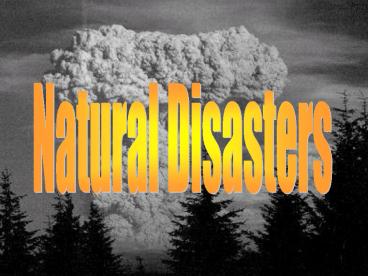Natural Disasters - PowerPoint PPT Presentation
1 / 32
Title:
Natural Disasters
Description:
* * Earthquake Hazards I. Lands - can be caused by earthquake hundreds of miles away Three main types: 1. Fall - usually from a cliff 2. Slip - i.e. slump 3. – PowerPoint PPT presentation
Number of Views:98
Avg rating:3.0/5.0
Title: Natural Disasters
1
Natural Disasters
2
Earthquake Hazards
3
(No Transcript)
4
Earthquake Hazards
I. Landslides
- can be caused by earthquake hundreds of miles
away
Three main types
1. Fall - usually from a cliff
2. Slip - i.e. slump
3. Flow - i.e. avalanche
Loess - wind blown sediment deposits
5
Earthquake Hazards
I. Landslides
- 1995 landslide in La Conchita, California
- 2005 landslide in La Conchita, California
6
Earthquake Hazards
II. Liquefaction
the fluidization of fairly solid ground
Three main types
1. Flow - saturated sediments move
horizontally (often toward lower elevations)
7
Earthquake Hazards
II. Liquefaction
2. Fountaining - geyser of water and sand
created by heavy layer of rock on saturated sand.
8
Earthquake Hazards
II. Liquefaction
3. Flotation - saturated sand on the surface
becomes liquefied. Objects could float or sink.
9
Earthquake Hazards
II. Liquefaction
- can cause major structural damage.
10
Earthquake Hazards
II. Liquefaction
- Susceptibility of SF Bay area to liquefaction
11
Earthquake Hazards
III. Floods
Quake Lake
Four main types
1. Impoundment Flood - landslide blocks
rivers flow, causing water to rise upstream.
Non-lethal. Plenty of time to evacuate. Mostly
property damage.
12
Earthquake Hazards
III. Floods
2. Damburst Flood - contents of lake are
released downstream due to damage to dam or levee
Very lethal! May result after impoundment flood.
13
Earthquake Hazards
III. Floods
3. Displacement Flood - Water is forced out
of a lake or river by a landslide or large-scale
surface deformation.
14
Earthquake Hazards
III. Floods
4. Transgression Flood - Coastal land sinks
during earthquake and ocean/lake/river water
moves in.
This type is permanent.
15
Earthquake Hazards
IV. Great Waves
A. Tsunamis - extremely large waves that can
travel across entire oceans and cause great
destruction.
16
Earthquake Hazards
IV. Great Waves
A. Tsunamis
- What causes a tsunami?
- Violent shaking or surface deformation creates
a shallow wave that covers a large area.
- Ships at sea will not feel it.
- May move up to a couple hundred miles per hour
in open ocean.
- As it nears land, the front edge of the wave
slows down, but the back remains fast. Along
with a shallow shore, this causes the wave to
increase in height.
- Sometimes, hundreds of feet high.
17
Earthquake Hazards
IV. Great Waves
A. Tsunamis
18
Earthquake Hazards
IV. Great Waves
A. Tsunamis
- Are they very destructive?
19
Earthquake Hazards
IV. Great Waves
A. Tsunamis
20
Earthquake Hazards
IV. Great Waves
B. Seiche - sloshing of water back and forth
in a lake or enclosed harbor.
- usually minimal damage / only reaches a few
yards high.
21
Earthquake Hazards
IV. Great Waves
C. Bore - single crest of water rushing along
a river, often upstream.
- can smash or overturn boats
- example - Mississippi River, 1811-1812
22
Earthquake Hazards
IV. Great Waves
D. Displacement Wave - great wave caused by
displacement of water, due to landslide or
underwater ground deformation.
- occurs in lakes or enclosed harbors.
- example - Lituya Bay, Alaska - landslide
pushed water 1720 ft. up opposite shore.
23
Earthquake Hazards
V. Structure Failure
- causes the most loss of life
- even in recent years, 1000s killed due to
lack of building codes.
- China, Mexico, Armenia, and Turkey have all
lost over 15,000 in single quakes in the past 25
years due to poorly built structures.
- When looking at susceptibility to earthquakes,
we need to consider three aspects
24
Earthquake Hazards
V. Structure Failure
A. Foundation
- Structures built on solid rock stand up better
than structures built on sand or loose sediment.
25
Earthquake Hazards
V. Structure Failure
B. Materials
- People build with what they have.
Historically, it has been adobe, wood, or stone.
- Which is the most earthquake resistant?
- Wood has much more necessary flexibility.
Which is the least earthquake resistant?
Adobe - 100,000s killed in China due to
adobe building collapses.
- Today, we use steel. It is extremely strong
but will also bend slightly. Often used to
reinforce concrete.
26
Earthquake Hazards
V. Structure Failure
C. Design
- Most buildings constructed to resist vertical
forces, not horizontal forces.
- Two big problems?
1. Resonance - If an earthquake shakes the
ground at the same frequency of the building, the
building itself will amplify the shaking and
literally shake itself apart.
- Mexico City, 1985 - 98 of all collapsed
buildings in the downtown area were between 6 and
18 stories high. Very few of the shorter or
taller buildings collapsed.
27
Earthquake Hazards
V. Structure Failure
C. Design
- Structure failure in Mexico City, 1985.
28
Earthquake Hazards
V. Structure Failure
C. Design
- Two big problems?
2. Outside ornaments or facade can fall off.
29
(No Transcript)
30
Earthquake Hazards
VI. Fire
- Sometimes an earthquake can cause a fire so
enormous that the earthquake itself is the lesser
of the two evils.
- Lisbon (1755), San Francisco (1906), Tokyo
(1923).
- How does an earthquake cause such disastrous
fires?
- historically, extensive use of wood in
buildings and open flames for cooking.
- broken gas lines and electrical lines
- destruction of firefighting equipment and
water lines
- large number of separate fires that grow into
one enormous fire
- flammability of household items (couches, beds)
31
Earthquake Hazards
VI. Fire
32
What is this and how did it kill 40,000 people?































